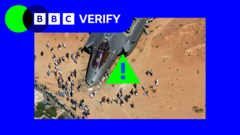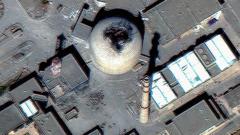New satellite imagery has unveiled extensive damage to key Iranian nuclear facilities and military installations, sparking international concern over the ongoing conflict in the region.
Satellite Images Uncover Damage to Iran’s Nuclear and Military Facilities

Satellite Images Uncover Damage to Iran’s Nuclear and Military Facilities
Recent satellite imagery reveals significant destruction to Iran's vital nuclear and military sites following escalated strikes.
Recent satellite images from different providers, analyzed by BBC Verify, have illuminated the consequences of military strikes that targeted critical nuclear sites in Iran. Noteworthy among the damaged facilities are the Natanz nuclear site and several missile bases, including a significant missile installation close to Tabriz, which sustained hits during the initial wave of attacks on Friday.
The Maxar satellite images offer detailed insight into the destruction inflicted on Natanz, revealing damage at the pilot fuel enrichment plant and an electrical substation. This assessment aligns with insights shared by the Institute for Space and International Security (ISIS). Concurrently, the head of the International Atomic Energy Agency (IAEA), Rafael Grossi, informed the UN Security Council that a substantial portion of the pilot fuel enrichment plant, where Iran was enriching uranium to nearly 60% U-235, has been destroyed. The enriched Uranium-235 is pivotal not only for nuclear energy but also for the development of nuclear arms.
Visible plumes of smoke from verified footage shortly after the strikes hint at the intensity of the assaults. Experts such as Justin Bronk from the Royal United Services Institute (RUSI) indicated that the explosion patterns suggest the use of penetrating munitions, like GBU-31(V)3s or more specialized GBU-28s, often referred to as “bunker busters.” While there were reports of extensive damage, Grossi remarked that there are "no indications" of a direct hit on the underground facilities crucial for uranium enrichment.
The IAEA also confirmed that essential buildings in Isfahan suffered damage, specifically targeting the uranium conversion facility and the fuel plate fabrication plant. These findings have been corroborated by Maxar imagery, which highlights visible destruction at Isfahan and scorch marks in surrounding areas.
Furthermore, no radiation increase has been reported from the Natanz or Isfahan sites, providing some reassurance regarding potential nuclear fallout. In addition to nuclear targets, satellite imagery sourced from Umbra Space has depicted damage to missile storage and launch sites near Tabriz, showcasing the widespread impact of recent military engagements. Additionally, extensive burn marks have been noted near a Kermanshah missile base, along with damage to associated structures, as supported by recent footage.
Maxar imagery has also indicated significant destruction at facilities tied to Iran's Islamic Revolutionary Guard Corps, specifically at its Ghadir ballistic missile base near Tehran, and significant damage to a radar site in West Azerbaijan Province, heightening concerns about the region's security dynamics.



















